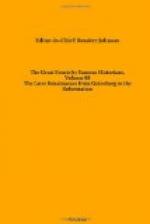The numerical weakness of the Greek army rendered it incapable of defending so large a city as Constantinople, even with all the advantage to be derived from strong fortifications. The Emperor was therefore anxious to obtain the assistance of the warlike citizens of the Italian republics, where good officers and experienced troops were then numerous. As he had no money to engage mercenaries, he could only hope to succeed by papal influence. An embassy was sent to Pope Nicholas V, begging immediate aid, and declaring the Emperor’s readiness to complete the union of the churches in any way the Pope should direct. Nicholas despatched Cardinal Isidore, the Metropolitan of Kiev, who had joined the Latin Church, as his legate. Isidore had represented the Russian Church at the Council of Florence; but on his return to Russia he was imprisoned as an apostate, and with difficulty escaped to Italy. He was by birth a Greek; and being a man of learning and conciliatory manners, it was expected that he would be favorably received at Constantinople.
The Cardinal arrived at Constantinople in November, 1452. He was accompanied by a small body of chosen troops, and brought some pecuniary aid, which he employed in repairing the most dilapidated part of the fortifications. Both the Emperor and the Cardinal deceived themselves in supposing that the dangers to which the Greek nation and the Christian Church were exposed would induce the orthodox to yield something of their ecclesiastical forms and phrases. It was evident that foreign aid could alone save Constantinople, and it was absurd to imagine that the Latins would fight for those who treated them as heretics and who would not fight for themselves. The crisis therefore compelled the Greeks to choose between union with the Church of Rome or submission to the Ottoman power. They had to decide whether the preservation of the Greek empire was worth the ecclesiastical sacrifices they were called upon to make in order to preserve their national independence.
In the mean time the emperor Constantine celebrated his union with the papal Church, in the Cathedral of St. Sophia, on December 12, 1452. The court and the great body of the dignified clergy ratified the act by their presence; but the monks and the people repudiated the connection. In their opinion, the Church of St. Sophia was polluted by the ceremony, and from that day it was deserted by the orthodox. The historian Ducas declares that they looked upon it as a haunt of demons, and no better than a pagan shrine. The monks, the nuns, and the populace publicly proclaimed their detestation of the union; and their opposition was inflamed by the bigotry of an ambitious pedant, who, under the name of Georgius Scholarius, acted as a warm partisan of the union at the Council of Florence, and under the ecclesiastical name of Gennadius is known in history as the subservient patriarch of Sultan Mahomet II. On returning from Italy, he made a great parade of his repentance for complying with the unionists at Florence. He shut himself up in the monastery of Pantokrator, where he assumed the monastic habit and the name of Gennadius, under which he consummated the union between the Greek Church and the Ottoman administration.




